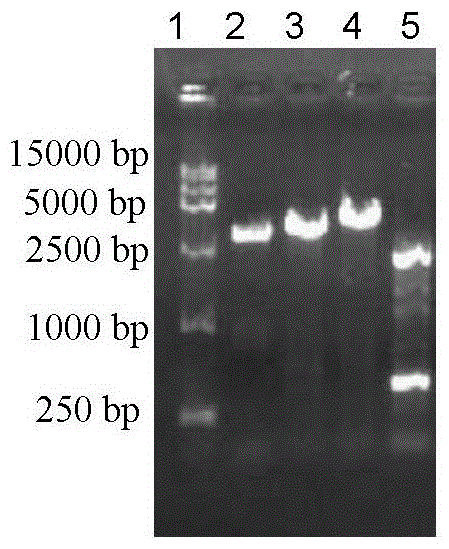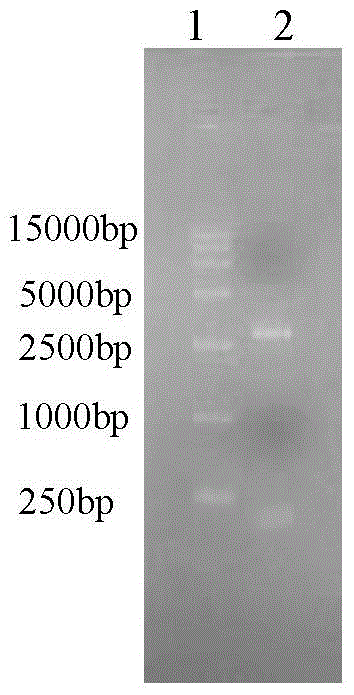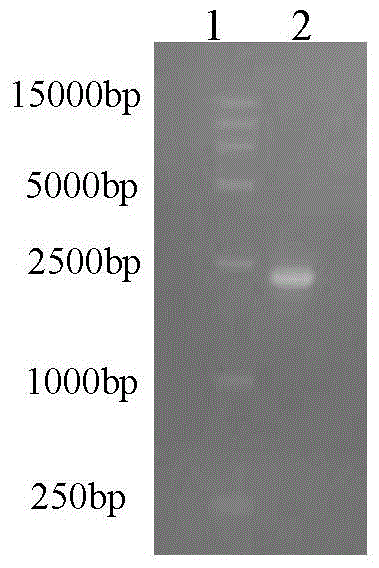Recombinant Infectious Cloning Plasmid of Japanese Encephalitis Virus Attenuated Strain and Its Application
A Japanese encephalitis virus, infectious cloning technology, applied in the field of bioengineering, can solve the problems of insertion, instability of JEV genome cDNA clone, difficulty in establishing virus infectious clone, etc., achieves broad application prospects, and is conducive to prevention and control Effect
- Summary
- Abstract
- Description
- Claims
- Application Information
AI Technical Summary
Problems solved by technology
Method used
Image
Examples
Embodiment 1
[0044] Example 1 Screening of Japanese Encephalitis Virus (JEV) HEN0701 Passage Attenuated Strain
[0045] The JEV GI strain HEN0701 was continuously passaged on BHK-21 cells for 100 passages, and was continuously purified 10 times with plaques, and 6 clones were selected to inoculate mice subcutaneously and intracranially to screen attenuated strains. The specific process is as follows:
[0046] 1.1 Virus passage
[0047] BHK-21 cells grown in a confluent monolayer in a 35 mm cell culture dish were washed once with 1 mL of PBS, and the HEN0701 strain was inoculated into BHK-21 cells. After incubating at 37°C for 1 h, wash once with 1 mL of PBS, add 2.5 mL of MEM containing 2% FBS to each plate to maintain culture medium, and place at 37°C containing 5% CO 2 incubator. When 70-80% of the BHK-21 cells inoculated with HEN0701 were damaged, the cell supernatant was harvested, divided into 1.5mL centrifuge tubes, and frozen at -70°C. This batch of viruses was called HEN0701P1. ...
Embodiment 210
[0053] Cloning of embodiment 210S3 whole genome
[0054] According to the whole genome sequence of JEV HEN0701 strain with accession number FJ495189 in Genbank, 4 pairs of primers were designed and synthesized as RT and PCR primers, respectively. Viral genomic RNA was extracted from the infected supernatant of the attenuated JEV strain 10S3, cDNA was synthesized by reverse transcription, and used as a PCR template, PCR amplification was performed using 4 pairs of primers to obtain 4 cDNA fragments, and the 4 cDNA fragments were respectively cloned into In the pCR-Blunt II-TOPO vector, select positive clones and determine the cloned cDNA sequence. Using the SeqMan software in DNAStar, the measured sequences were spliced to obtain the full-length viral genome sequence. And use the MegAlign software in DNAStar to compare the measured 10S3 genome sequence with HEN0701. The specific process is as follows:
[0055] 2.1 Primer design
[0056] According to the whole genome seque...
Embodiment 3
[0073] Construction of embodiment 3 attenuated JEV strain 10S3 full-length infectious clone
[0074] Design synthetic primers, add T7 promoter sequence at the 5' end of 10S3 genome by PCR method, add hepatitis D virus ribozyme sequence (delta hepatitis virus ribozyme, HDVr) sequence at the 3' end, and use site-directed mutagenesis PCR method, The genome 9291 base C was mutated to G, thus forming a SacII site at this site. Through specific restriction sites, the cDNA fragments modified at both ends and the two cDNA fragments in the middle were constructed in the pBR322 vector to construct the full-length cDNA clone pAHEN of 10S3 strain. pAHEN was linearized by enzyme digestion, RNA was transcribed in vitro and transfected into BHK-21 cells to obtain infectious virus, which was called vAHEN. vAHEN infects BHK-21 cells and can be specifically recognized by JEV NS3 monoclonal antibody. The vAHEN cDNA fragment amplified by PJEF8791 / PJER10965 can be cut by SacII. The specific pro...
PUM
 Login to View More
Login to View More Abstract
Description
Claims
Application Information
 Login to View More
Login to View More - R&D
- Intellectual Property
- Life Sciences
- Materials
- Tech Scout
- Unparalleled Data Quality
- Higher Quality Content
- 60% Fewer Hallucinations
Browse by: Latest US Patents, China's latest patents, Technical Efficacy Thesaurus, Application Domain, Technology Topic, Popular Technical Reports.
© 2025 PatSnap. All rights reserved.Legal|Privacy policy|Modern Slavery Act Transparency Statement|Sitemap|About US| Contact US: help@patsnap.com



